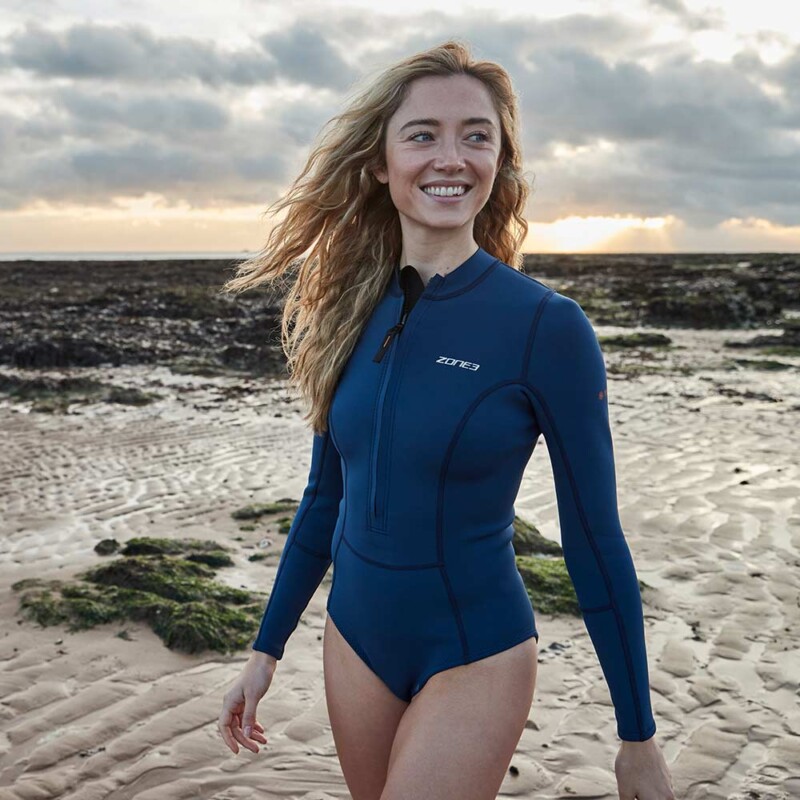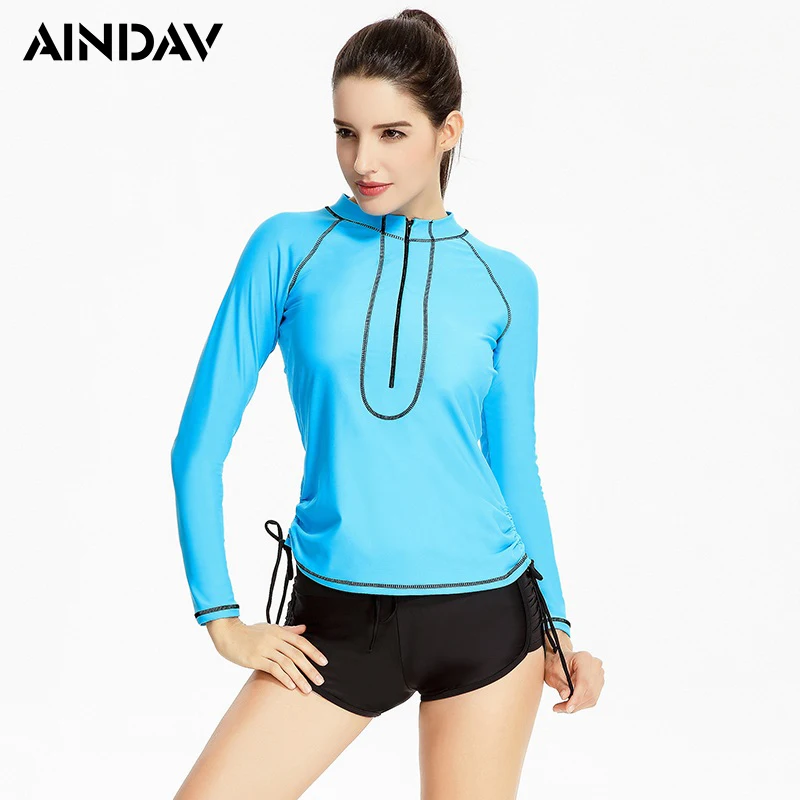Content Menu
● Understanding Thermal Swimwear
● Key Features of Thermal Swimwear
● Benefits of Thermal Swimwear
● Types of Thermal Swimwear
● Choosing the Right Thermal Swimwear
● Caring for Thermal Swimwear
● The Future of Thermal Swimwear
● Video Resources
● Conclusion
● Frequently Asked Questions
>> Q: How does thermal swimwear differ from regular swimsuits?
>> Q: Can thermal swimwear be used for activities other than swimming?
>> Q: How do I choose the right thickness for my thermal swimwear?
>> Q: Is it necessary to wear anything underneath thermal swimwear?
Thermal swimwear, also known as thermal wetsuits or thermal swimsuits, is a specialized type of aquatic attire designed to keep swimmers warm and comfortable in cold water conditions. As the popularity of open water swimming, triathlon, and various water sports continues to grow, the demand for effective thermal protection has led to significant advancements in swimwear technology. In this comprehensive article, we will explore the world of thermal swimwear, its benefits, features, and why it has become an essential piece of equipment for many water enthusiasts.

Understanding Thermal Swimwear
Thermal swimwear is specifically engineered to provide insulation and warmth to swimmers in cold water environments. Unlike traditional swimsuits, which offer minimal protection against the cold, thermal swimwear is constructed using materials and designs that help maintain body heat and reduce heat loss to the surrounding water.
The primary purpose of thermal swimwear is to extend the amount of time a swimmer can comfortably and safely spend in cold water. This is particularly important for open water swimmers, triathletes, and individuals participating in water activities in cooler climates or during colder seasons.
Key Features of Thermal Swimwear
1. Insulating Materials: Thermal swimwear is typically made from neoprene, a synthetic rubber material known for its excellent insulating properties. The thickness of the neoprene can vary, usually ranging from 2mm to 5mm, depending on the level of thermal protection required.
2. Thermal Lining: Many thermal swimsuits feature a special thermal lining, often made from materials like fleece or titanium-infused fabrics. This lining helps to trap a thin layer of water between the skin and the suit, which is then warmed by body heat, creating an additional barrier against the cold.
3. Strategic Paneling: Thermal swimwear often incorporates different thicknesses of neoprene in various areas of the suit. Thicker panels are usually placed around the core to provide maximum insulation for vital organs, while thinner panels are used in areas that require more flexibility, such as the arms and shoulders.
4. Seam Construction: To minimize water entry and maximize heat retention, thermal swimwear often features sealed or taped seams. This construction technique helps to prevent cold water from seeping into the suit through the stitching.
5. Zipper Systems: Many thermal wetsuits come with high-quality, water-resistant zippers, often located at the back or chest. These zippers are designed for easy entry and exit while minimizing water ingress.
6. Adjustable Collars and Cuffs: To further prevent water from entering the suit, thermal swimwear often includes adjustable collars and cuffs. These features allow for a snug fit around the neck and wrists, creating a better seal against the cold water.

Benefits of Thermal Swimwear
1. Extended Swimming Time: The primary advantage of thermal swimwear is that it allows swimmers to stay in cold water for longer periods. This is particularly beneficial for endurance swimmers, triathletes, and those training for long-distance open water events.
2. Improved Safety: By helping to maintain core body temperature, thermal swimwear reduces the risk of hypothermia and other cold-water related health issues. This added layer of safety is crucial for those swimming in challenging conditions or remote locations.
3. Increased Comfort: The insulating properties of thermal swimwear not only keep swimmers warmer but also provide a more comfortable experience overall. This can lead to improved performance and enjoyment of water activities.
4. Versatility: Thermal swimwear is suitable for a wide range of water activities beyond just swimming. It can be used for surfing, paddleboarding, kayaking, and other water sports in cooler conditions.
5. UV Protection: Many thermal swimsuits offer excellent UV protection, shielding the skin from harmful sun rays during outdoor water activities.
Types of Thermal Swimwear
1. Full-Body Wetsuits: These cover the entire body from neck to ankles and wrists, providing maximum thermal protection. They are ideal for very cold water conditions or extended periods of immersion.
2. Shorty Wetsuits: These suits cover the torso, upper arms, and upper legs, offering a balance between thermal protection and freedom of movement. They are suitable for moderately cold water or shorter swimming sessions.
3. Thermal Swimsuits: These look more like traditional swimsuits but are made with thermal materials. They often feature long sleeves and may extend to the knees, providing thermal protection while maintaining a sleek profile.
4. Thermal Rash Guards: These are long-sleeved tops made from thermal materials, designed to be worn alone or under a wetsuit for additional warmth.
5. Thermal Accessories: In addition to the main swimwear, there are various thermal accessories available, such as gloves, booties, and swim caps, which can provide extra warmth to extremities.

Choosing the Right Thermal Swimwear
When selecting thermal swimwear, several factors should be considered:
1. Water Temperature: The colder the water, the thicker and more comprehensive the thermal protection should be. For very cold water (below 10°C/50°F), a full-body wetsuit with a thickness of 5mm or more is often recommended.
2. Activity Type: Different water activities may require different styles of thermal swimwear. For example, a triathlete might prefer a suit that allows for quick transitions, while a recreational open water swimmer might prioritize maximum warmth.
3. Fit: Thermal swimwear should fit snugly without being restrictive. A proper fit ensures that the suit functions effectively in trapping and warming the thin layer of water between the skin and the suit.
4. Duration of Activity: For longer swimming sessions or events, investing in higher-quality thermal swimwear with advanced features may be worthwhile for improved comfort and performance.
5. Personal Tolerance to Cold: Some individuals are more sensitive to cold than others. Personal comfort levels should be taken into account when choosing the level of thermal protection.
Caring for Thermal Swimwear
To ensure the longevity and effectiveness of thermal swimwear, proper care is essential:
1. Rinse thoroughly with fresh water after each use to remove salt, chlorine, and other contaminants.
2. Hang to dry in a shaded area, away from direct sunlight which can degrade the materials.
3. Store on a wide hanger to maintain the shape of the suit.
4. Avoid using harsh detergents or machine washing, as this can damage the neoprene and other specialized materials.
5. Regularly inspect seams and zippers for any signs of wear and repair promptly if needed.
The Future of Thermal Swimwear
As technology advances and the demand for high-performance swimwear grows, we can expect to see continued innovation in the field of thermal swimwear. Some emerging trends include:
1. Eco-friendly Materials: Many manufacturers are exploring sustainable alternatives to traditional neoprene, such as plant-based or recycled materials.
2. Smart Fabrics: Integration of smart textiles that can actively respond to temperature changes or even generate heat.
3. Improved Flexibility: Development of materials that offer excellent thermal properties without compromising on flexibility and range of motion.
4. Customization: Advancements in manufacturing techniques may lead to more personalized thermal swimwear options, tailored to individual body shapes and specific needs.

Video Resources
To further illustrate the features and benefits of thermal swimwear, here are some informative video resources:
1. Zone3 Ti+ Thermal Long Sleeve Swimsuit Review This video provides an in-depth review of a specific thermal swimsuit, showcasing its key features and benefits.
2. Top 3 Long Sleeve Swimsuits and Wetsuits for Swimming Warmer This video compares different options for thermal swimwear, helping viewers understand the various choices available.
3. Zoggs Thermal Swimwear Try On This video demonstrates how thermal swimwear looks and fits when worn, giving a practical perspective on the product.
4. Thermal or Non-Thermal: Which Wetsuit to Go For? This short video explains the differences between thermal and non-thermal wetsuits, helping viewers make an informed choice.
Conclusion
Thermal swimwear has revolutionized cold water swimming and water sports, making it possible for enthusiasts to enjoy their favorite activities year-round and in a wider range of environments. By understanding the features, benefits, and considerations associated with thermal swimwear, swimmers can make informed decisions about their gear, enhancing both their performance and enjoyment in the water.
As we continue to push the boundaries of water-based activities, thermal swimwear will undoubtedly play a crucial role in keeping us safe, comfortable, and performing at our best, no matter how cold the water may be.
Frequently Asked Questions
Q: How does thermal swimwear differ from regular swimsuits?
A: Thermal swimwear is specifically designed to provide insulation and warmth in cold water, typically made from materials like neoprene. Regular swimsuits are primarily for modesty and reducing drag, offering minimal thermal protection.
Q: Can thermal swimwear be used for activities other than swimming?
A: Yes, thermal swimwear is versatile and can be used for various water activities such as surfing, paddleboarding, kayaking, and other water sports in cooler conditions.
Q: How do I choose the right thickness for my thermal swimwear?
A: The appropriate thickness depends on water temperature and personal tolerance to cold. Generally, for water temperatures below 10°C/50°F, a thickness of 5mm or more is recommended, while for warmer waters, 2-3mm may be sufficient.
Q: Is it necessary to wear anything underneath thermal swimwear?
A: Typically, thermal swimwear is designed to be worn directly against the skin without additional layers underneath. This allows for optimal insulation and heat retention.
Q: How long does thermal swimwear typically last?
A: With proper care, high-quality thermal swimwear can last for several years. However, factors such as frequency of use, exposure to sunlight, and proper maintenance can affect its lifespan.





































